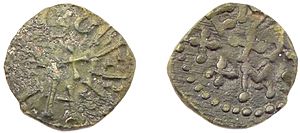Osberht of Northumbria facts for kids
Quick facts for kids Osberht |
|
|---|---|

A styca of Osberht
|
|
| King of Northumbria | |
| Reign | c. 849 – c. 862 AD |
| Predecessor | Æthelred II |
| Successor | Ælla |
| Died | 21 March 867 |
| House | Northumbria |
Osberht was a king of Northumbria, a powerful kingdom in what is now northern England, during the middle of the 9th century. He died on March 21, 867. We don't have many records from this time, so much of Osberht's life and rule remains a mystery. We don't even know who his parents were, and the exact years he reigned are hard to pinpoint.
Becoming King of Northumbria
Osberht became king after the previous ruler, Æthelred II, was killed. Historians believe Æthelred died around the year 848. One old record says that Osberht ruled for thirteen years after Æthelred's death. This would mean he became king around 854.
Not much is known about what Osberht did during his time as king. One historical account mentions that he took some lands from a church. These lands were called Wercewurde and Tillemuthe. This happened just a year before Osberht died.
Eventually, another man named Ælla took over as king. Many old writings describe Ælla as a harsh ruler who wasn't the rightful king. However, one source suggests that Ælla might have been Osberht's brother.
The Viking Invasion
A huge Viking army, known as the Great Heathen Army, arrived in Northumbria in the late summer of 866. These fierce warriors quickly captured the important city of York on November 21, 866. Several historical accounts, like the Anglo-Saxon Chronicle, tell a similar story of these events.
Osberht and Ælla, who were rivals, decided to join forces against the Vikings. They led their armies to fight the invaders in York. Sadly, both kings were killed in the battle on March 21, 867. After this victory, the Vikings put their own ruler, Ecgberht, in charge of Northumbria.
Some historians believe King Osberht might have been buried in a place called Thornhill in Yorkshire. Old gravestones from that time, including one with his name, were found there.
Viking Legends and Revenge
Some old Norse stories, called sagas, add more exciting details to the Viking conquest of York. These tales connect the invasion to a famous Viking leader named Ragnar Lodbrok and his sons. According to these legends, Ragnar was killed by King Ælla. To get revenge for their father's death, Ragnar's sons led the Great Heathen Army that attacked York in 866. They supposedly captured Ælla and performed a brutal ritual called the "blood eagle" on him.
However, earlier English records simply state that both Osberht and Ælla died in battle. The Anglo-Saxon Chronicle says, "both the kings were slain on the spot." The main Viking leader in these revenge stories is often Ivar the Boneless. He is sometimes linked to a real Viking leader named Ímar, who was active in Ireland. But historians aren't sure if they are the same person.
Other Viking leaders mentioned in historical accounts include Halfdene, Inguar, Hubba, and Guthrun. Some stories also say that an Englishman named Bern or Buern helped bring the Danes (Vikings) to England.

